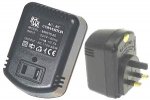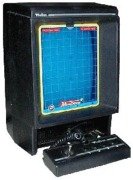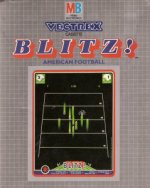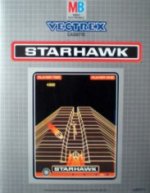Website Temporary Closed
Vectrex
The Vectrex is an 8-bit video game console developed by General Consumer Electric (GCE) and later bought by Milton Bradley Company. The Vectrex is unique in that it utilized vector graphics drawn on a monitor that was integrated in the console. It was released in November 1982 at a retail price of $199 in the USA. As the video game market declined and then crashed, the Vectrex exited the market in early 1984.
Smith Engineering briefly considered designing a handheld version of the device in 1988, though the success of the Nintendo Game Boy made such a project too risky. In the mid-1990s, Smith Engineering condoned the duplication of the Vectrex system image and cartridges for non-commercial uses and has expressed joy to see that it has still-thriving developer and user communities.
[collapse collapsed title=read more...]
Unlike other video game consoles which connected to TVs to display raster graphics, the Vectrex included its own monitor which displayed vector graphics. The monochrome Vectrex used screen overlays to give the illusion of color, and also to reduce the severity of the inherent flickering caused by the vector monitor. At the time many of the most popular arcade games used vector displays, and GCE was looking to set themselves apart from the pack by selling high-quality versions of games like Space Wars and Armor Attack. The system even contained a built in game, the Asteroids-like Minestorm.
The cathode ray tube was a Samsung model 240RB40 monochrome unit measuring 9 x 11 inches, displaying a picture of 240mm diagonal. A vector display such as the Vectrex does not require a special tube, and differs only in the control circuits. Rather than use sawtooth waves to divert the internal electron beam in a raster pattern, digital-to-analog converters drove the horizontal and vertical deflection magnets. The high-voltage transformers and tube remained the same as a television. Such technology was already established by arcade games such as Asteroids.
The Vectrex did not have any luminance control, but rather brightness was adjusted by drawing some lines more frequently than others. Screen upgrades were hindered by the cost of redesigning the analog circuits. Likewise it was impossible to connect the Vectrex to a home television.
The two peripherals for the Vectrex were a light pen and 3D imager. Even today there are new games in development by homebrew video game programmers. Also new hardware (for example VecVox, a speech synthesizer) is available.
[/collapse]
- HOME


- PRODUCTS

- 3DO
- Amiga CD32
- Amstrad GX4000
- Atari 2600
- Atari 7800
- Atari Jaguar
- Atari Jaguar CD
- Atari Lynx
- Bandai Wonderswan
- Coleco
- Colecovision
- Famicom
- Famicom Disk System
- Grandstand
- JAMMA
- Mattel Intellivision
- MB
- Microsoft Xbox
- MSX
- Neo Geo AES
- Neo Geo CD
- Neo Geo MVS
- Neo Geo Pocket
- Nintendo 64
- Nintendo Game and Watch
- Nintendo Gameboy
- Nintendo Gameboy Advance
- Nintendo Gameboy Colour
- Nintendo Gamecube
- Nintendo NES
- Nintendo Virtual Boy
- PC Engine
- PC Engine CD
- Philips CDI
- Sega 32X
- Sega Dreamcast
- Sega Game Gear
- Sega Genesis
- Sega Master System
- Sega Mega CD
- Sega Megadrive
- Sega Nomad
- Sega Saturn
- Sony Playstation
- Sony Playstation 2
- Super Famicom
- Super Nintendo
- Texas Instruments
- Tiger Game Com
- Tomy
- Vectrex
- Japanese Video Game Imports
-

- MODIFICATIONS

- Switchless Modification
- Modification Sega 32X
- Modification Sega Dreamcast
- Modification Sega Megadrive
- Modification Neo Geo AES
- Modification Neo Geo CD
- Modification Nintendo NES
- Modification Sega Master System
- Modification Sega Mega-CD
- Modification Sega Nomad
- Modification Sega Saturn
- Modification Super Nintendo
-

- TECHNICAL INFO


- NEWS


- ABOUT US


- MEMBERS


- CONTACT US


Log on
x
Just In!












 Save time
Save time